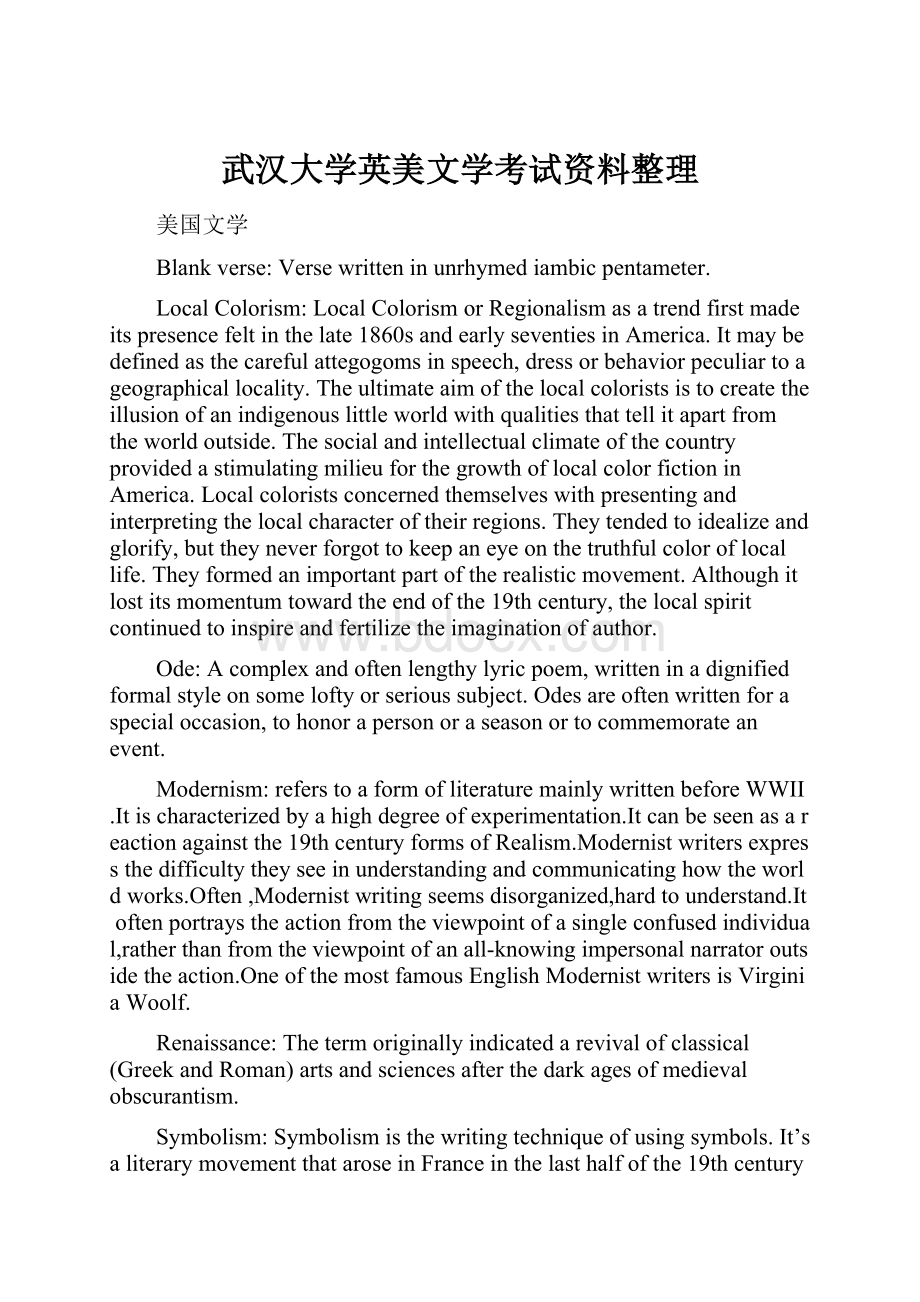武汉大学英美文学考试资料整理.docx
《武汉大学英美文学考试资料整理.docx》由会员分享,可在线阅读,更多相关《武汉大学英美文学考试资料整理.docx(13页珍藏版)》请在冰豆网上搜索。

武汉大学英美文学考试资料整理
美国文学
Blankverse:
Versewritteninunrhymediambicpentameter.
LocalColorism:
LocalColorismorRegionalismasatrendfirstmadeitspresencefeltinthelate1860sandearlyseventiesinAmerica.Itmaybedefinedasthecarefulattegogomsinspeech,dressorbehaviorpeculiartoageographicallocality.Theultimateaimofthelocalcoloristsistocreatetheillusionofanindigenouslittleworldwithqualitiesthattellitapartfromtheworldoutside.ThesocialandintellectualclimateofthecountryprovidedastimulatingmilieuforthegrowthoflocalcolorfictioninAmerica.Localcoloristsconcernedthemselveswithpresentingandinterpretingthelocalcharacteroftheirregions.Theytendedtoidealizeandglorify,buttheyneverforgottokeepaneyeonthetruthfulcoloroflocallife.Theyformedanimportantpartoftherealisticmovement.Althoughitlostitsmomentumtowardtheendofthe19thcentury,thelocalspiritcontinuedtoinspireandfertilizetheimaginationofauthor.
Ode:
Acomplexandoftenlengthylyricpoem,writteninadignifiedformalstyleonsomeloftyorserioussubject.Odesareoftenwrittenforaspecialoccasion,tohonorapersonoraseasonortocommemorateanevent.
Modernism:
refers to a form of literature mainly written before WWII.It is characterized by a high degree of experimentation.It can be seen as a reaction against the 19th century forms of Realism.Modernist writers express the difficulty they see in understanding and communicating how the world works.Often ,Modernist writing seems disorganized,hard to understand.It often portrays the action from the viewpoint of a single confused individual,rather than from the viewpoint of an all-knowing impersonal narrator outside the action.One of the most famous English Modernist writers is Virginia Woolf.
Renaissance:
Thetermoriginallyindicatedarevivalofclassical(GreekandRoman)artsandsciencesafterthedarkagesofmedievalobscurantism.
Symbolism:
Symbolismisthewritingtechniqueofusingsymbols.It’saliterarymovementthataroseinFranceinthelasthalfofthe19thcenturyandthatgreatlyinfluencedmanyEnglishwriters,particularlypoets,ofthe20thcentury.Itenablespoetstocompressaverycomplexideaorsetofideasintooneimageorevenoneword.It’soneofthemostpowerfuldevicesthatpoetsemployincreation.
红字
TheScarletLetter:
Analysis
It’sanovelofverycomplexandambiguousmeaning.Fromthedifferenteffectsof“humansin”ondifferentcharacters,thestoryprobesintotherelationshipbetweengoodandevil,betweenindividualandsociety,andintotheconflictsbetweenoldandnewmoralities.Ithashighlightedthestruggleofindividual’spassionwithreligiousandsocialrationalityandweighedbetweenrigidandcruelPuritanideologyandunboundTranscendentalistpropaganda.However,thestory’sinterpretationofnature,bothhumannatureandthenatureofwholeuniverse,isadialecticalone.
TheScarletLetter:
Characterization
HesterPrynne:
ofgreatcontradictionsandconflicts
ArthurDimmesdale:
heavilycontroversial
RogerChillingworth:
detestablebutpitiable
Pearl:
anidealisticyetfictitiousfairy-likespirit
Othercharacters:
ascontrastingfoilsandobserverstobeinstructedandenlightened
TheScarletLetter:
Meaning
againstradicalismandextremity
understandingandtoleranceofhumanandsocialimperfection
philosophyofgoldenmean
The letter “A”
Allstands for the crime adultery.to the puritans it is a symbol of just punishment .
to Hester, a device of unjust humiliation ; to Dimmesdale, a piercing reminder of his guilt;
to Chillingworth, a spur to the quest of revenge;to Pearl, a bright and mysterious curiosity.
人物形象:
HesterPrynne:
Hesterisportrayedasanintelligent,capable,woman.Shespeculatesonhumannature,socialorganization,andlargermoralquestions.Hester’stribulationsalsoleadhertobestoicandafreethinker.Shecaresforthepoorandbringsthemfoodandclothing.
ArthurDimmesdale:
Dimmesdalewasascholar.ThefactthatHestertakesalloftheblamefortheirsharedsingoadshisconscience,andhisresultantmentalanguishandphysicalweaknessopenuphismindandallowhimtoempathizewithothers.ThepersonalguiltdrivesDimmesdaletofurtherinternalizehisguiltandself-punishmentandleadstostillmoredeteriorationinhisphysicalandspiritualcondition.
RogerChillingworth:
RogerChillingworthisamandeficientinhumanwarmth.Histwisted,stooped,deformedshouldersmirrorhisdistortedsoul.Heisinterestedinrevenge,notjustice,andheseeksthedeliberatedestructionofothersratherthanaredressofwrongs.HisdesiretohurtothersstandsincontrasttoHesterandDimmesdale’ssin.
Pearl:
Hester’sdaughter,makesusconstantlyawareofhermother’sscarletletterandofthesocietythatproducedit.Pearl’sinnocent,orperhapsintuitive,commentsabouttheletterraisecrucialquestionsaboutitsmeaning.
欲望号街车
Blanche:
Used to be a high school English teacher,but was forced to leave her post.A loquacious and fragile woman,lived in her own imagination.A fallen woman in society's eyes,a relic from a defunct social hierachy,an insecure,dislocated individual.Had strong sexual urges and a bad drinking problem,but pretended to be a woman who had known indignity.Depended on male sexual admiration for he sense of self-esteem.
Stanley:
The epitome of vital force.Loyal to his friends,passionate to his wife,heartlessly cruel to Blanche,but lacked ideal and imagination.Represents the new heterogeneous America which Blanche doesn't belong.Disturbing,degenerte nature,first hinted at when he beated his wife,was fully evident after raped his sister-in-law.Shows no remose for his brutal actions.
Stella:
剧中“温和”的人物,她调节着布兰奇和史丹利两个相对立的人,同时也在两者中徘徊着。
她的挣扎强度也介于布兰奇与史丹利中间,随着事件的发展深入,她的挣扎也越来越明显,直至最后爆发。
但我并不认为故事的最后,史黛拉在决心要离开之后就真的会倾向布兰奇那边,因为她最终也只是跑去了楼上。
一方面,在丈夫史坦利面前,她是顺从丈夫的,另一方面,在姐姐布兰奇面前,她也有对高雅生活的渴望,或者说对于女权的一种向往,因此她会变现得不再那么服从丈夫。
随着布兰奇和史坦利矛盾的加深,史黛拉既不想失去丈夫,又不想要尊重姐姐的挣扎更加明显,直到布兰奇疯了以后,史黛拉送走了布兰奇,自己的愤怒也达到了顶点,于是她决定离开丈夫。
史黛拉作为一个中庸性格的人,虽然此前有过心理挣扎,但是仍会选择当下一种比较平稳的生活方式。
史黛拉现实化、大众化。
Mitch:
AnnabelLee(Edgar Allan Poe)
Rhyme, Rhythm, Repetition:
Poe uses three R’s–rhyme, rhythm, and repetition–in “Annabel Lee” to create a harmony of sounds that underscore the exquisite harmony of the narrator’s relationship with his beloved.
Rhyme and Repetition
Throughout the poem, Poe repeats the soud of long "e." For example, in the first stanza, Line 2 ends with sea, Line 4 with Lee, and Line 6 with me. Stanzas 2 and 3 repeat the sea, Lee, me pattern, although Stanza 3 adds a second end-rhyming sea. Stanza 4 alters the pattern to me, sea, and Lee. Stanza 5 uses we, we, sea, and Lee; the last stanza uses Lee, Lee, sea, and sea. A notable example of internal rhyme occurs in the last line of Stanza 4:
“Chilling and killing my Annabel Lee.”
Rhythm and Repetition
The lines of the poem alternate in length between a long line (usually with 9 to 11syllables) and a short line (usually with 6 to 8 syllables), as in the first stanza:
.......It was many and many a year ago, (11 syllables)
.......In a kingdom by the sea, (7 syllables)
.......That a maiden there lived whom you may know (10 syllables)
.......By the name of Annabel Lee (8 syllables)
.......And this maiden she lived with no other thought (11 syllables)
.......Than to love and be loved by me. (8 syllables)
Poe repeats this rhythmic pattern throughout the poem, perhaps to suggest the rise and fall of the tides. He also repeats key phrases–such as in this kingdom by the sea and my Annabel Lee (or my beautiful Annabel Lee)–to create haunting refrains. In addition, Poe sometimes repeats words or word patterns within a single line, as in
(1) many and many a year ago,
(2) we loved with a love that was more than love, and (3) my darling–my darling. Poe further enhances the rhythm of the poem with the repetition of consonant sounds (alliteration). Notice, for example, the repetition of the “w” and “l” sounds in this line in Stanza 2:
But we loved with a love that was more than love." Poe sometimes couples repetition of consonant sounds with repetition of vowel sounds,
as in many and many, love and be loved, and those who were older than we.
BecauseIcouldnotstopfordeath(Emily Dickinson)
The poem is discussing death, a very gloomy subject, but it is done with a rather light tone. The tone is light just because the author does not take death as a catastrophe; instead, she treats the angel of death as a very polite gentleman, as a long-missing guest:
giving up her work and leisure, putting on her fine silky dresses, she accompanies death in the same carriage to eternity. All the beauty of this work lies in the poetess' open-minded attitude towards death.
Inthispoem,Dickinsondescribesdyingandimmortalityinthedominantmetaphorofacarriageonajourney.InStanza1,Death,accompaniedbyImmortality,stopstopickupthespeakerinacarriage.Instanzas2-4,theyjourney,leavingearthlylifebehindthem(labor,leisure,children,grain,settingsun).Instanza5,theypausebeforethegrave(swellingoftheground),andstanza6depictsthespeakercenturieslater,speakingfrometernity.
TheRomanticPeriod
Ⅰ浪漫主义时期
WashingtonIrving(华盛顿·欧文)
RalphWaldoEmerson(拉尔夫·华尔多·爱默生)
NathanielHawthorne(纳撒尼尔·霍桑)
WaltWhitman(华尔特·惠特曼)
HermanMelville(赫尔曼·麦尔维尔)
TheRealistciPeriod
Ⅱ现实主义时期
MarkTwain(马克·吐温)
HenryJames(亨利·詹姆斯)
EmilyDickinson(艾米丽·狄金森)
TheodoreDreiser(西奥多·德莱塞)
TheModernPeriod
Ⅲ现代主义时期
EzraPound(埃兹拉·庞德)
RobertLeeFrost(罗伯特·佛洛斯特)
EugeneO’Neil(尤金·奥尼尔)
F.ScottFitzgerald(司各特·菲兹杰拉德)
EarnestHemingway(欧内斯特·海明威)
WilliamFaulkner(威廉·福克纳)
英国文学
TheRenaissancePeriod
Ⅰ文艺复兴时期
EdmundSpenser(埃德蒙·斯宾塞)
ChristopherMarlowe(克里斯托夫·马洛)
WilliamShakespeare(威廉·莎士比亚)
Fr